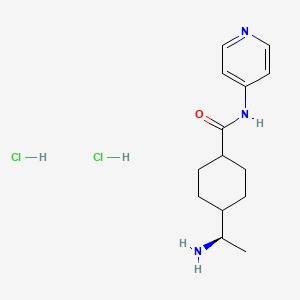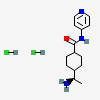(1R,4r)-4-((R)-1-aminoethyl)-N-(pyridin-4-yl)cyclohexanecarboxamide dihydrochloride
- 129830-38-2
- Y-27632 dihydrochloride
- Y-27632 2HCl
- Y 27632 dihydrochloride
- Y-27632 (dihydrochloride)
- Create:2006-10-25
- Modify:2025-01-04

- 129830-38-2
- Y-27632 dihydrochloride
- Y-27632 2HCl
- Y 27632 dihydrochloride
- Y-27632 (dihydrochloride)
- (1R,4r)-4-((R)-1-aminoethyl)-N-(pyridin-4-yl)cyclohexanecarboxamide dihydrochloride
- Cyclohexanecarboxamide, 4-[(1R)-1-aminoethyl]-N-4-pyridinyl-, hydrochloride (1:2), trans-
- Rock inhibitor y-27632
- Q9828II7F3
- trans-4-((R)-1-aminoethyl)-N-(pyridin-4-yl)cyclohexanecarboxamide dihydrochloride
- Y-27632 (dihydrochloride) (GMP)
- C14H23Cl2N3O
- MFCD03490488
- 4-[(1R)-1-aminoethyl]-N-pyridin-4-ylcyclohexane-1-carboxamide;dihydrochloride
- (R)-4-(1-Aminoethyl)-N-(pyridin-4-yl)cyclohexane-1-carboxamide dihydrochloride
- 1983329-96-9
- Y27632 2HCl
- Y 27632 hydrochloride
- UNII-Q9828II7F3
- 4-[(1R)-1-AMINOETHYL]-N-(PYRIDIN-4-YL)CYCLOHEXANE-1-CARBOXAMIDE DIHYDROCHLORIDE
- Y 27632 HCl
- (R)-(+)-trans-4-(1-Aminoethyl)-N-(4-Pyridyl)cyclohexanecarboxamide dihydrochloride
- CYCLOHEXANECARBOXAMIDE, 4-((1R)-1-AMINOETHYL)-N-4-PYRIDINYL-, HYDROCHLORIDE (1:2), TRANS-
- C14H21N3O.2HCl
- SCHEMBL819701
- SCHEMBL819702
- CHEMBL536267
- CHEMBL1605605
- DTXSID3042635
- EX-A423
- CHEBI:232591
- EX-A3440
- WFA98650
- Tox21_500333
- HB2297
- HY-10583G
- HY-10583R
- AKOS024456492
- Y-27632 2HCL?
- CCG-100675
- CS-0878
- trans-4-[(1R)-1-Aminoethyl]-N-4-pyridinylcyclohexanecarboxamide dihydrochloride
- NCGC00092276-01
- NCGC00093773-01
- NCGC00261018-01
- Y-27632 (dihydrochloride) (Standard)
- AC-35974
- AS-74311
- BY162499
- HY-10583
- CS-0615630
- S1049
- SW219086-1
- Y0018
- Y-27632 dihydrochloride, >=98% (HPLC)
- SR-00000001060
- J-005723
- SR-00000001060-1
- Q27287129
- Y-27632 - CAS 146986-50-7
- (+)-(R)-TRANS-4-(1-AMINOETHYL)-N-(4-PYRIDYL)CYCLOHEXANECARBOXAMIDE DIHYDROCHLORIDE
- (R)-(+)-TRANS-N-(4-PYRIDYL)-4-(1-AMINOETHYL)-CYCLOHEXANECAR BOXAMIDE, 2HCL
- (r)-(+)-trans-N-(4-pyridyl)-4-(1-aminoethyl)-cyclohexanecarboxamide dihydrochloride
- (1R,4R)-4-[(1R)-1-AMINOETHYL]-N-(PYRIDIN-4-YL)CYCLOHEXANE-1-CARBOXAMIDE DIHYDROCHLORIDE
- CYCLOHEXANECARBOXAMIDE, 4-((1R)-1-AMINOETHYL)-N-4-PYRIDINYL-, DIHYDROCHLORIDE, TRANS-

H302+H312+H332 (33.3%): Harmful if swallowed, in contact with skin or if inhaled [Warning Acute toxicity, oral; acute toxicity, dermal; acute toxicity, inhalation]
H302 (33.3%): Harmful if swallowed [Warning Acute toxicity, oral]
H312 (33.3%): Harmful in contact with skin [Warning Acute toxicity, dermal]
H332 (33.3%): Harmful if inhaled [Warning Acute toxicity, inhalation]
P261, P264, P270, P271, P280, P301+P317, P302+P352, P304+P340, P317, P321, P330, P362+P364, and P501
(The corresponding statement to each P-code can be found at the GHS Classification page.)
Aggregated GHS information provided per 3 reports by companies from 3 notifications to the ECHA C&L Inventory. Each notification may be associated with multiple companies.
Reported as not meeting GHS hazard criteria per 1 of 3 reports by companies. For more detailed information, please visit ECHA C&L website.
There are 2 notifications provided by 2 of 3 reports by companies with hazard statement code(s).
Information may vary between notifications depending on impurities, additives, and other factors. The percentage value in parenthesis indicates the notified classification ratio from companies that provide hazard codes. Only hazard codes with percentage values above 10% are shown.
Acute Tox. 4 (33.3%)
Acute Tox. 4 (33.3%)
Acute Tox. 4 (33.3%)
Patents are available for this chemical structure:
https://patentscope.wipo.int/search/en/result.jsf?inchikey=IDDDVXIUIXWAGJ-DDSAHXNVSA-N
- ChEMBLLICENSEAccess to the web interface of ChEMBL is made under the EBI's Terms of Use (http://www.ebi.ac.uk/Information/termsofuse.html). The ChEMBL data is made available on a Creative Commons Attribution-Share Alike 3.0 Unported License (http://creativecommons.org/licenses/by-sa/3.0/).http://www.ebi.ac.uk/Information/termsofuse.htmlChEMBL Protein Target Treehttps://www.ebi.ac.uk/chembl/g/#browse/targets
- ChemIDplusY 27632 dihydrochloridehttps://pubchem.ncbi.nlm.nih.gov/substance/?source=chemidplus&sourceid=0129830382ChemIDplus Chemical Information Classificationhttps://pubchem.ncbi.nlm.nih.gov/source/ChemIDplus
- EPA DSSToxY 27632 dihydrochloridehttps://comptox.epa.gov/dashboard/DTXSID3042635CompTox Chemicals Dashboard Chemical Listshttps://comptox.epa.gov/dashboard/chemical-lists/
- European Chemicals Agency (ECHA)LICENSEUse of the information, documents and data from the ECHA website is subject to the terms and conditions of this Legal Notice, and subject to other binding limitations provided for under applicable law, the information, documents and data made available on the ECHA website may be reproduced, distributed and/or used, totally or in part, for non-commercial purposes provided that ECHA is acknowledged as the source: "Source: European Chemicals Agency, http://echa.europa.eu/". Such acknowledgement must be included in each copy of the material. ECHA permits and encourages organisations and individuals to create links to the ECHA website under the following cumulative conditions: Links can only be made to webpages that provide a link to the Legal Notice page.https://echa.europa.eu/web/guest/legal-notice4-[(1R)-1-aminoethyl]-N-pyridin-4-ylcyclohexane-1- carboxamide;hydrate;dihydrochloridehttps://echa.europa.eu/substance-information/-/substanceinfo/100.244.9734-[(1R)-1-aminoethyl]-N-pyridin-4-ylcyclohexane-1- carboxamide;hydrate;dihydrochloride (EC: 813-428-5)https://echa.europa.eu/information-on-chemicals/cl-inventory-database/-/discli/details/252924
- FDA Global Substance Registration System (GSRS)LICENSEUnless otherwise noted, the contents of the FDA website (www.fda.gov), both text and graphics, are not copyrighted. They are in the public domain and may be republished, reprinted and otherwise used freely by anyone without the need to obtain permission from FDA. Credit to the U.S. Food and Drug Administration as the source is appreciated but not required.https://www.fda.gov/about-fda/about-website/website-policies#linkingY-27632 DIHYDROCHLORIDEhttps://gsrs.ncats.nih.gov/ginas/app/beta/substances/Q9828II7F3
- Springer Nature
- WikidataY-27632 dihydrochloridehttps://www.wikidata.org/wiki/Q27287129
- PubChem
- ChEBI
- GHS Classification (UNECE)GHS Classification Treehttp://www.unece.org/trans/danger/publi/ghs/ghs_welcome_e.html
- MolGenieMolGenie Organic Chemistry Ontologyhttps://github.com/MolGenie/ontology/
- PATENTSCOPE (WIPO)SID 390601076https://pubchem.ncbi.nlm.nih.gov/substance/390601076


 CID 448042 (Y-27632 dihydrochloride)
CID 448042 (Y-27632 dihydrochloride) CID 313 (Hydrochloric Acid)
CID 313 (Hydrochloric Acid)